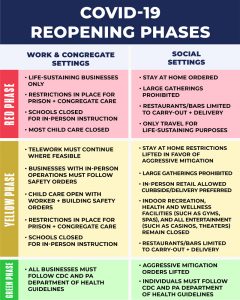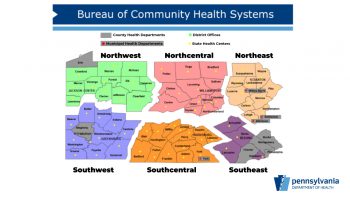By Mike McGann, Editor, The Times @mikemcgannpa
 Gov. Tom Wolf unveiled a plan to start reopening the state in three phases — with some portions of the north-central and northwest portions of the state likely to see the first steps back toward an open economy as soon as May 8. Chester County — part of the southeast region of the plan — probably won’t meet the criteria at that point, but could follow within weeks if current COVID-19 trend numbers hold.
Gov. Tom Wolf unveiled a plan to start reopening the state in three phases — with some portions of the north-central and northwest portions of the state likely to see the first steps back toward an open economy as soon as May 8. Chester County — part of the southeast region of the plan — probably won’t meet the criteria at that point, but could follow within weeks if current COVID-19 trend numbers hold.
Wolf established three phases: Red (the current lock down, which is statewide), Yellow, more open, including retail and some offices (work at home will be encouraged), but with restrictions on large gatherings such as concerts and sporting events, and Green, a full resumption of all activities. Schools will remain closed until fall at the earliest.
The administration will first study conditions in the north-central and northwest regions with a target of moving from red to yellow on May 8. Additional monitoring will take place and direction will be provided in the next week.
To decide when to move a region to a new phase, the administration will use Department of Health metrics and a data tool developed by Carnegie Mellon University. The full plan is available here.
To determine when a region is ready to reopen and return to work, the state will evaluate the incidence rate of COVID-19 cases per capita, relying upon existing regional health districts used by the Pennsylvania Department of Health. A regional assessment will measure the COVID-19 cases to determine if the target goals of an average of less than 50 cases per 100,000 individuals over the course of 14 days is met. The administration will work closely with county and local governments to enable the communities to reopen and transition back to work.
 In the case of Chester County, the timing will likely depend on neighboring counties, Lancaster, Berks, Schuykill, Delaware, Montgomery, Bucks and Philadelphia counties — while Chester County is trending toward meeting the standard, it is not clear other southeast counties are faring as well yet.
In the case of Chester County, the timing will likely depend on neighboring counties, Lancaster, Berks, Schuykill, Delaware, Montgomery, Bucks and Philadelphia counties — while Chester County is trending toward meeting the standard, it is not clear other southeast counties are faring as well yet.
Also, it is unclear which numbers — locally produced numbers or state DOH numbers, which have been a bit higher, will be used.
Late Wednesday, county Health issued a statement on the differential in reporting on fatalities between the state and county:
“The unusual jump in the number of Chester County COVID-19 deaths reported by the PA Department of Health today (4/22/2020) reflects a reconciliation in systems between numbers previously reported by hospitals and coroners, and numbers provided to health departments,” the statement said. “This reconciliation includes a respective review of COVID-19 deaths between both original reporting systems, and this process will be used from this point on to help all reporting to be more consistent and accurate.”
DOH again revised its numbers — based on pushback from some counties — downward, no longer counting deaths from untested or patients awaiting test results, but presumed to be from COVID-19.
Statewide, new COVID-19 number edged up again, DOH said Thursday, with 1,368 new cases, bringing the state’s total of infections to 37,053.
“As we see the number of new COVID-19 cases continuously change across the state that does not mean we can stop practicing social distancing,” Sec. of Health Dr. Rachel Levine said. “We must continue to stay home to protect ourselves, our families and our community. If you must go out, please make as few trips as possible and wear a mask to protect not only yourself, but others. We need all Pennsylvanians to continue to heed these efforts to protect our vulnerable Pennsylvanians, our health care workers and frontline responders.”
Wolf also announced the launch of an online portal for individuals, corporations or community organizations to inform the commonwealth of critical medical supplies available for donation during the COVID-19 pandemic.
“We’ve received a lot of inquiries from people and businesses that want to help first responders and medical professionals,” said PEMA Director Randy Padfield. “While some people are reaching out directly to their local emergency management office or health care facilities, we are able to coordinate efforts for donations of larger quantities or for anyone who doesn’t know how to get these supplies to those who need them.”
Even amid stabilizing numbers of new COVID-19 cases, these supplies are needed most: surgical/procedure masks; form fitting respirators (ex. N95/N99); face masks with integrated shield; medical grade alcohol – based hand sanitizer; aprons; protective gloves; protective goggles; isolation gowns; protective suits; and sanitizing wipes.






